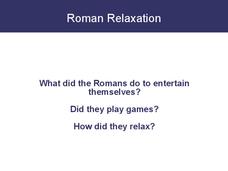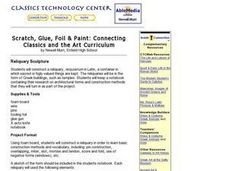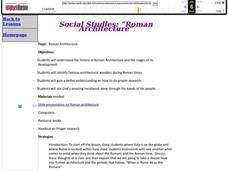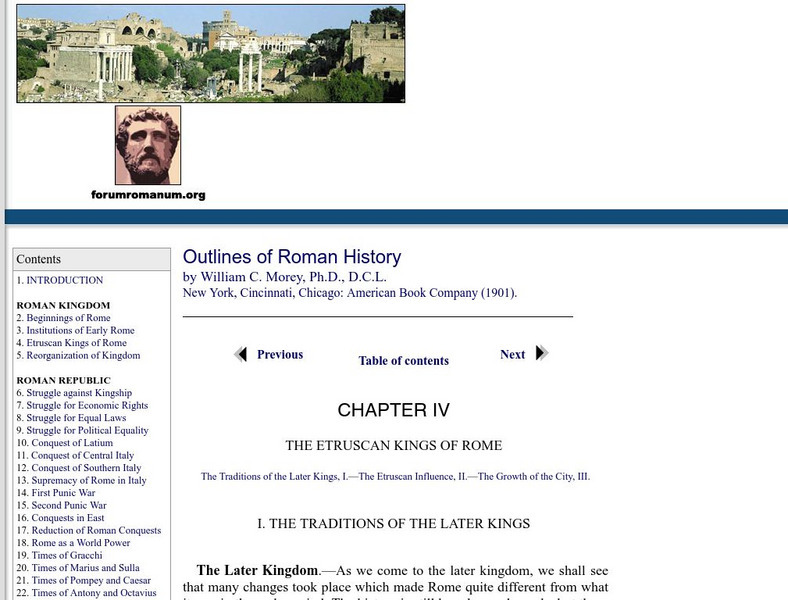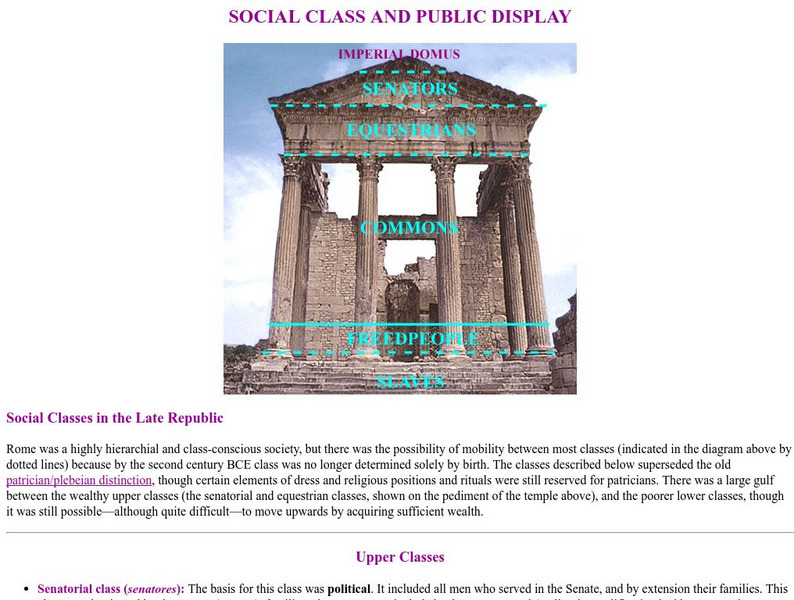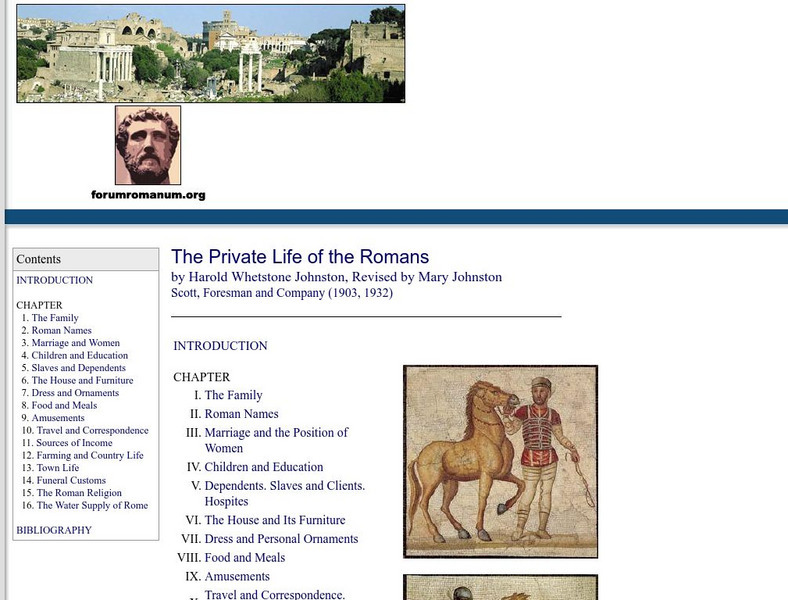University of California
Bread and Circuses: Rome as a Site of Encounter
An intriguing lesson uses 12 Roman artifacts to explain Roman society and politics. Young historians view images of artifacts and learn how each one represents an aspect of Roman society. Academics also complete a hands-on activity to...
Mr. Roughton
Roman Empire
Does the United States parallel the Roman Empire in any way? Young historians work with four documents in order to answer this query as part of a structured DBQ assignment.
Curated OER
Roman Art, Architecture, and Engineering
There is no better tool to help you explain art or architecture than an image-filled slide show. Classic Greek art, architecture, and engineering are all described with excellent visual examples and text which defines each form by its...
Curated OER
Roman Relaxation
So what did the ancient Romans do to have fun? Explore the Colosseum, amphitheaters, baths, and arenas that housed the exciting and at times dangerous activities enjoyed in ancient Rome. An interesting look at ancient life!
Curated OER
What the Romans Did for Us.
What things can we attribute to the ancient Romans? Check out each of these images to find out. There are 26 slides, each containing a single image of Roman legacy that can still be seen today. Architecture, art, libraries, cats, and...
Curated OER
Roman Contributions
A basic overview of one of the most powerful civilizations of all time, these slides don't quite do justice to the mighty Roman Empire. Slides featuring Roman contributions to modern society, such as the aqueduct and distinctive Roman...
Curated OER
Aqueduct Architecture: Moving Water to the Masses in Ancient Rome
Ninth graders compare ancient and modern technology in water transporting. In this lesson plan on the evolution of the aqueduct, 9th graders build a working aqueduct model and examine its components. They explain the importance and use...
Curated OER
Roman Archy
Third graders use Google Earth to examine Roman architecture. In this ancient Rome lesson, 3rd graders visit the noted URLs to look at examples of Roman architecture. Students work in teams to examine data about the structures.
Curated OER
Scratch, Glue, Foil & Paint: Connecting Classics and the Art Curriculum
High schoolers construct a reliquary using foam board, researching basic Greek and Roman architecture and basic construction methods. They record their research and information in an architectural journal.
Curated OER
How Does Roman Civilization Affect Me?
If used as a template for a class assignment in history, this resource could be a discussion piece. Students could discuss what they thought was useful, and anything they might add. Or, a teacher could add information to make this...
Curated OER
Roman Architecture
Pupils examine Roman architecture. In this ancient Rome lesson, students discuss some attributes of Roman architecture prior to conducting research on the use of classical Roman architecture in modern buildings.
Curated OER
Culture Worksheet
In this world history worksheet, students reference their textbook to answer 18 short answer questions pertaining to Roman culture.
Curated OER
Relief Sculpture in Two Parts
Students discuss relief sculptures and examine many examples of Roman urns with relief sculptures. They consider the information these urns give us about Roman culture and then use drywall to design and create their own relief sculpture...
Forum Romanum
Outlines of Roman History: Beginnings of Rome: The Origin of the City
This article lays out the probable founding of the city of Rome, rather than the legendary one. Three tribes, occupying three different hills, make an alliance and unite as one city-state, eventually becoming the city of Rome.
Forum Romanum
Outlines of Roman History: Institutions of Early Rome: The Early Roman Society
The importance of family in Roman culture was apparent from the beginning of Rome. This article explains the structure of Roman society from the basic family unit to the tribe, a coalition of many families.
Forum Romanum
Outlines of Roman History: Institutions of Early Rome: The Early Roman Religion
Early Roman religion was based on the family with a strong "head of the family" in Jupiter. Because the early Romans were an agricultural society, much of the religion also centered on nature.
Forum Romanum
Outlines of Roman History: Etruscan Kings of Rome: Etruscan Influence
The Etruscans influenced not only the government of the Roman monarchy, but also the religious practices, and early architecture.
Forum Romanum
Outlines of Roman History: Third Punic War and Reduction of Africa
Read about the exciting and futile attempt by Carthage to resist capture and destruction by the Romans in the Third Punic War.
Forum Romanum
Outlines of Roman History: The New Civilization
With Rome's conquest of foreign lands, she assimilates many ideas for literature, architecture, art, religion, and philosophy.
Vroma Project
V Roma Project: Social Class and Public Display
This resource describes the evolution of Roman social classes from the Republic to the Empire as well as how these classes would distinguish themselves in public. It describes the system of patronage seen in Roman society. It also...
World Wide School
World Wide School: Chapter X: Science of the Roman Period
A description of the lack of original Roman science, focusing on the influence of Greek ideas and concepts on the Romans. Click on 'Next' at the end of the text to continue for four more pages on this topic. These talk about Strabo the...
Forum Romanum
Outlines of Roman History: Wars With the Volscians, Aequians, and Etruscans
In Morey's account of Rome's disputes with its neighbors, he includes stories of Roman heroes which exemplify classic Roman virtues.
Carnegie Mellon University
Carnegie Mellon University: Antique Roman Recipes
Provides recipes for many Roman dishes plus a listing of the some of the Roman ingredients such as "liquamen" (salty fish sauce) or "defritum" (thick fig syrup).
Forum Romanum
Outlines of Roman History: The Private Life of the Romans
The complete text of the book published in 1932 giving valuable details on the family life of Romans, the role of children and women, dress codes, water supplies, and much more.





